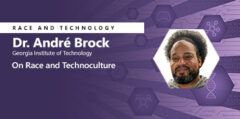The Vanishing Indian Speaks Back: Race, Genomics, and Indigenous Rights
Central to US history is the idea that Indigenous peoples were destined to vanish. It is a cherished national myth that the “red” race simply faded away, leaving empty land for inevitable occupation and development by white civilization. The classic image of “the Vanishing American” illustrates this myth; it graced early twentieth-century novels and movie posters, including a film by the same name. In that image, a stereotypical, nineteenth-century plains “Indian” sits on horseback, facing west into the sun that sets on his epoch. The Indian’s otherwise copper-colored body fades to white or disappears; these are the same outcome. After the Indian wars, white society assumed the Indian would finally die out and politicians tried to hurry things along. The US government mandated assimilation through education, child adoption, employment, and urban relocation programs designed to “kill the Indian and save the man.” US policy also defined the Indian out of existence by implementing the racial idea of diminishing “Indian blood quantum.” Such ideas continue to shape American thought, including the genome sciences.
Join University of Alberta Indigenous Science and Technology Studies scholar, Kim TallBear (Sisseton-Wahpeton Oyate), as she examines: 1) how older notions of race continue to influence genome scientists who study Indigenous populations today; and 2) the cultural politics involved in the marketing since the early 2000s of “Native American DNA” tests to an American public searching to appropriate Indigenous “identity.”
Learning Materials
- Publication: Narratives of Race and Indigeneity in the Genographic Project, 2007
- Book: Native American DNA: Tribal Belonging and the False Promise of Genetic Science, 2013
- Podcast appearance: Race Underneath The Skin | Code Switch on NPR, 2018
- Podcast appearance: Can a DNA Test Make Me Native American? | All My Relations Podcast, 2019
- Publication: Genomic articulations of indigeneity, 2013
- Podcast: Media Indigena: The Podcast, since 2016
Learn more about the Race and Technology Research Lecture Series >
发言人详细信息
Kim TallBear is Associate Professor and Canada Research Chair in Indigenous Peoples, Technoscience and Environment., Faculty of Native Studies, University of Alberta. She is the author of “Native American DNA: Tribal Belonging and the False Promise of Genetic Science.” In addition to studying genome science disruptions to Indigenous self-definitions, Dr. TallBear studies colonial disruptions to Indigenous sexualities. She is a regular panelist on the weekly podcast, Media Indigena, and a citizen of the Sisseton-Wahpeton Oyate.
- 日期:
- 演讲者:
- Dr. Kim TallBear
- 所属机构:
- Associate Professor and Canada Research Chair in Indigenous Peoples, Technoscience and Environment., Faculty of Native Studies, University of Alberta
系列: Race and Technology: A Research Lecture Series
-
Beyond the Technology: The Need for Identity-Inclusive Computing Education
Speakers:- Nicki Washington
-
-
-
-
Intersectional Tech: Black Praxis in Digital Gaming
Speakers:- Dr. Kishonna L. Gray
-
Towards a New Biology Nexus: Race, Society and Story in the Science of Life
Speakers:- Dr. C. Brandon Ogbunu
-
Our Genomes, Our Selves?
Speakers:- Dr. Sohini Ramachandran
-
On Race and Technoculture
Speakers:- Dr. André Brock
-
Acrylic, metal, blue and a means of preparation: Imagining and living Black life beyond the surveillance state
Speakers:- Dr. Simone Browne
-
Women of Color and the Digital Labor of Repair
Speakers:- Dr. Lisa Nakamura
-
The New Jim Code: Reimagining the Default Settings of Technology & Society
Speakers:- Dr. Ruha Benjamin
-
Computing Technology as Racial Infrastructure: A History of the Present & Blueprint for Black Future(s)
Speakers:- Dr. Charlton McIlwain
-
The Vanishing Indian Speaks Back: Race, Genomics, and Indigenous Rights
Speakers:- Dr. Kim TallBear
-
Racist Tropes and Labor Discipline: How Tech Inherits and Reproduces Global Imaginaries of Race and Work
Speakers:- Dr. Sareeta Amrute














